load capacity OLDSMOBILE CUTLASS 1997 Owners Manual
[x] Cancel search | Manufacturer: OLDSMOBILE, Model Year: 1997, Model line: CUTLASS, Model: OLDSMOBILE CUTLASS 1997Pages: 353, PDF Size: 16.72 MB
Page 175 of 353
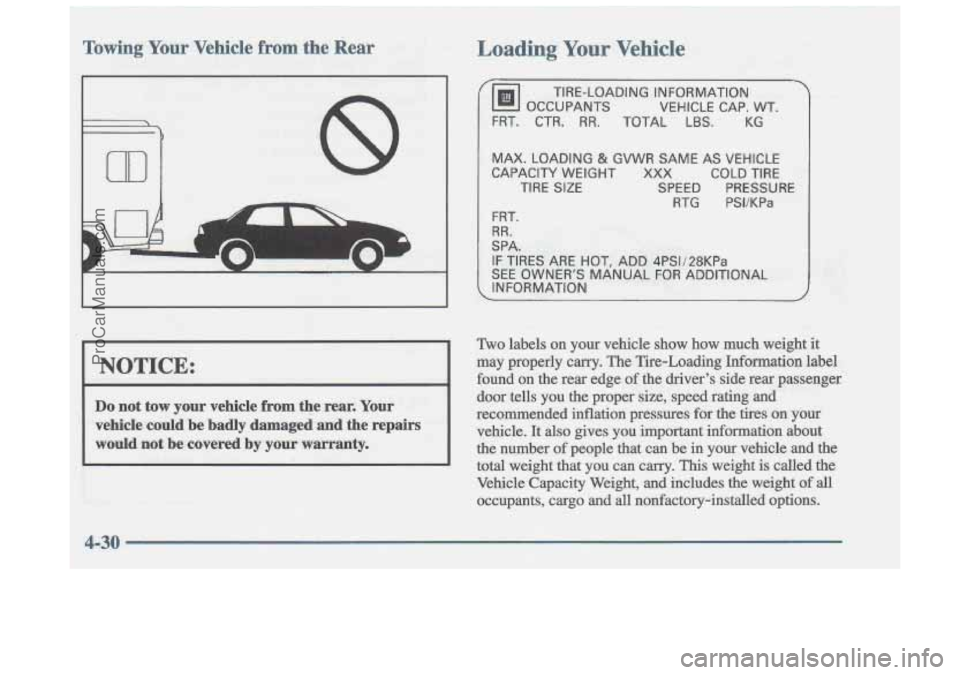
Towing Your Vehicle from the Rear
8
I NOTICE:
Do not tow your vehicle from the rear. Your
vehicle could be badly damaged and the repairs would not be covered by your warranty.
Loading Your Vehicle
Fm OCCUPANTS VEHICLE CAP. WT.
?
TIRE-LOADING INFORMATION
FRT. CTR.
RR. TOTAL LBS. KG
MAX. LOADING & GVWR SAME AS VEHICLE
CAPACITY WEIGHT XXX COLD TIRE
TIRE SIZE SPEED PRESSURE
RTG PSI/KPa
FRT.
RR.
SPA. IF TIRES ARE HOT, ADD 4PS1/28KPa
SEE OWNER'S MANUAL FOR ADDITIONAL
INFORMATION
Two labels on your vehicle show how much weight it
may properly carry. The Tire-Loading Information label
found on the rear edge
of the driver's side rear passenger
door tells you the proper size, speed rating and
recommended inflation pressures
for the tires on your
vehicle. It also gives you important information about
the number
of people that can be in your vehicle and the
total weight that you can carry.
This weight is called the
Vehicle Capacity Weight,
and includes the weight of all
occupants, cargo and all nonfactory-installed options.
4-30
ProCarManuals.com
Page 176 of 353
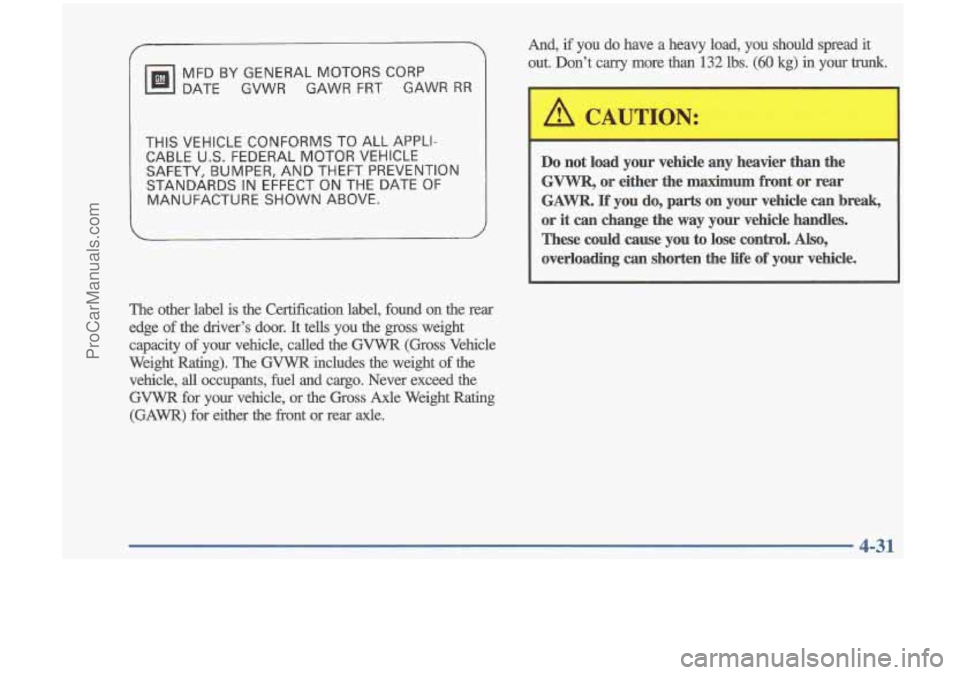
MFD BY GENERAL MOTORS CORP
DATE GVWR GAWR FRT GAWR RR
THiS VEHICLE CONFORMS TO ALL APPLI-
CABLE U.S. FEDERAL MOTOR VEHICLE SAFETY, BUMPER, AND THEFT PREVENTION
STANDARDS
IN EFFECT ON THE DATE OF
MANUFACTURE SHOWN ABOVE.
The other label is the Certification label, found on the rear
edge
of the driver’s door. It tells you the gross weight
capacity of your vehicle, called the
GVWR (Gross Vehicle
Weight Rating). The GVWR includes the weight of the vehicle,
all occupants, fuel and cargo. Never exceed the
GVWR for your vehicle, or the Gross Axle Weight Rating
(GAWR) for either the front or rear
axle.
And, if you do have a heavy load, you should spread it
out. Don’t carry more
than 132 lbs. (60 kg) in your trunk.
Do not load your vehicle any neavier than the
GVWR, or either the maximum front or rear
GAM. If you do, parts on your vehicle can break,
or it can change the way your vehicle handles.
These could came you to lose
control. Also,
overloading can shorten the life of your vehicle.
4-31
ProCarManuals.com
Page 178 of 353
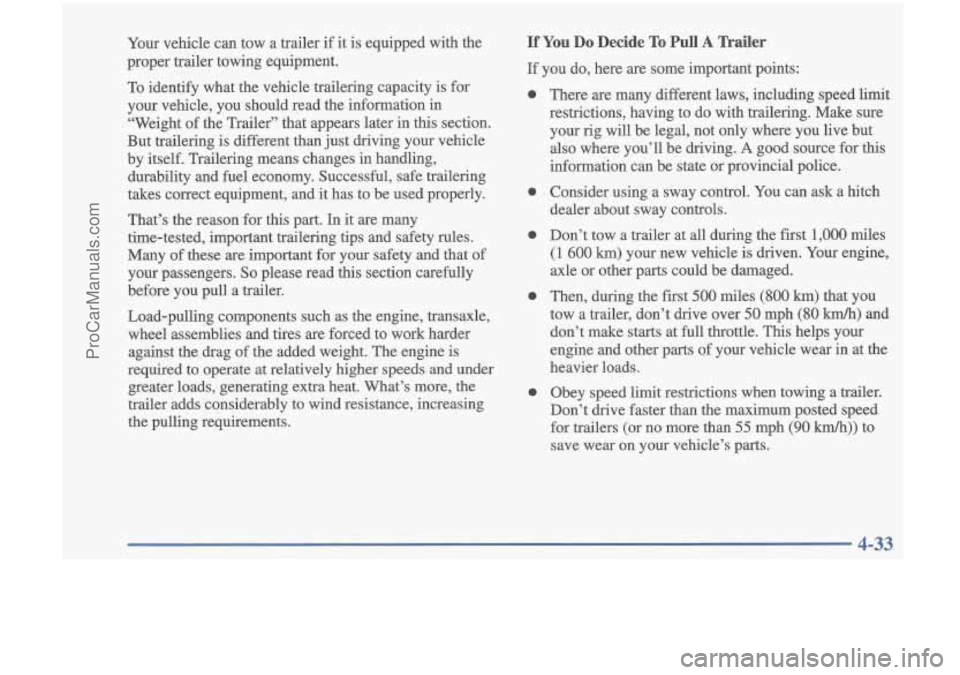
Your vehicle can tow a trailer if it is equipped with the
proper trailer towing equipment.
To identify what the vehicle trailering capacity is for
your vehicle, you should read the information in
“Weight of the Trailer” that appears later in this section.
But trailering is different than just driving your vehicle
by itself. Trailering means changes
in handling,
durability and fuel economy. Successful, safe trailering
takes correct equipment, and it has to be used properly.
That’s the reason for this part. In it are many
time-tested, important trailering tips and safety rules.
Many of these are important for your safety and that of
your passengers.
So please read this section carefully
before you pull a trailer.
Load-pulling components such as the engine, transaxle,
wheel assemblies and tires are forced to work harder
against the drag of the added weight. The engine is
required to operate at relatively higher
speeds^ and under
greater loads, generating extra heat. What’s more, the
trailer adds considerably to wind resistance, increasing
the pulling requirements.
If You Do Decide To Pull A Trailer
If you do, here are some important points:
0
0
0
0
e
There are many different laws, including speed limit
restrictions, having to
do with trailering. Make sure
your rig will be legal, not only where
you live but
also where you’ll be driving.
A good source for this
information can be state or provincial police.
Consider using a sway control. You can ask a hitch
dealer about sway controls.
Don’t tow a trailer at all during the first
1,000 miles
(1 600 km) your new vehicle is driven. Your engine,
axle or other parts could be damaged.
Then, during the first
500 miles (800 krn) that you
tow a trailer, don’t drive over
50 mph (80 km/h) and
don’t make starts at full throttle.
This helps your
engine and other parts of your vehicle wear
in at the
heavier loads.
Obey speed limit restrictions when towing a trailer.
Don’t drive faster than the maximum posted speed
for trailers (or no more than
55 mph (90 km/h)) to
save wear on your vehicle’s parts.
4-33
ProCarManuals.com
Page 179 of 353
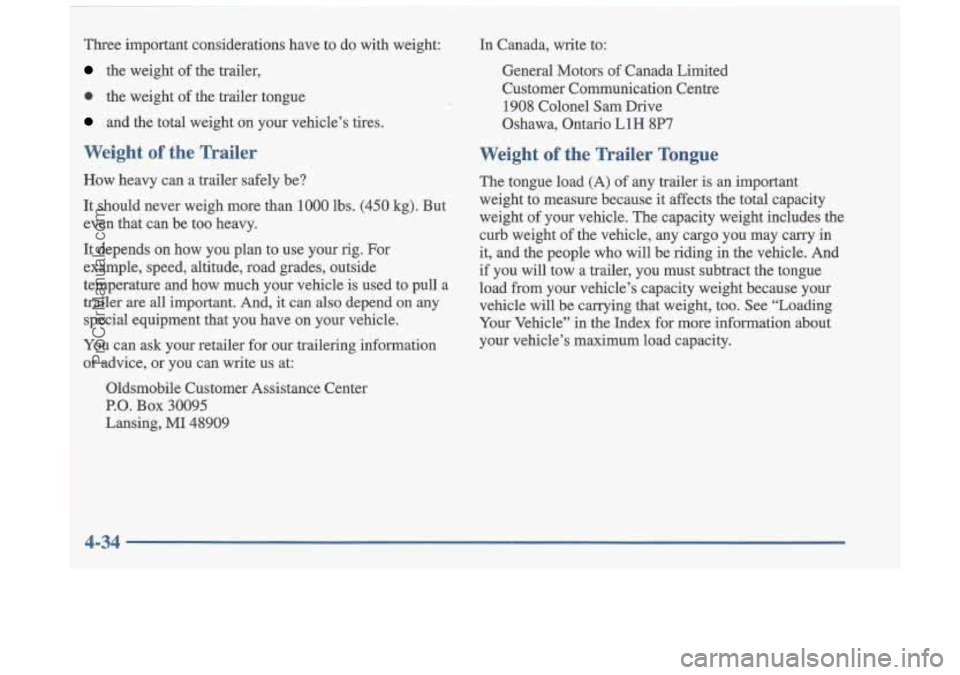
Three important considerations have to do with weight:
the weight of the trailer,
0 the weight of the trailer tongue
and the total weight on your vehicle’s tires.
Weight of the Trailer
How heavy can a trailer safely be?
It should never weigh more than
1000 lbs. (450 kg). But
even that can be too heavy.
It depends on how you plan
to use your rig. For
example, speed, altitude, road grades, outside
temperature and how much your vehicle is used to pull a
trailer are all important. And, it can also depend on any
special equipment that you have on your vehicle.
You can ask your retailer for our trailering information
or advice, or you can write
us at:
Oldsmobile Customer Assistance Center
P.O. Box 30095
Lansing,
MI 48909 In Canada, write to:
General Motors
of Canada Limited
Customer Communication Centre 1908 Colonel Sam Drive
Oshawa, Ontario L1H
8P7
Weight of the Trailer Tongue
The tongue load (A) of any trailer is an important
weight to measure because it affects the total capacity
weight
of your vehicle. The capacity weight includes the
curb weight of the vehicle, any cargo you may cany in
it, and the people who will be riding in the vehicle. And
if you will tow a trailer, you must subtract the tongue
load from your vehicle’s capacity weight because
your
vehicle will be carrying that weight, too. See “Loading
Your Vehicle” in the Index for more information about
your vehicle’s maximum load capacity.
’ 4-34
ProCarManuals.com
Page 261 of 353
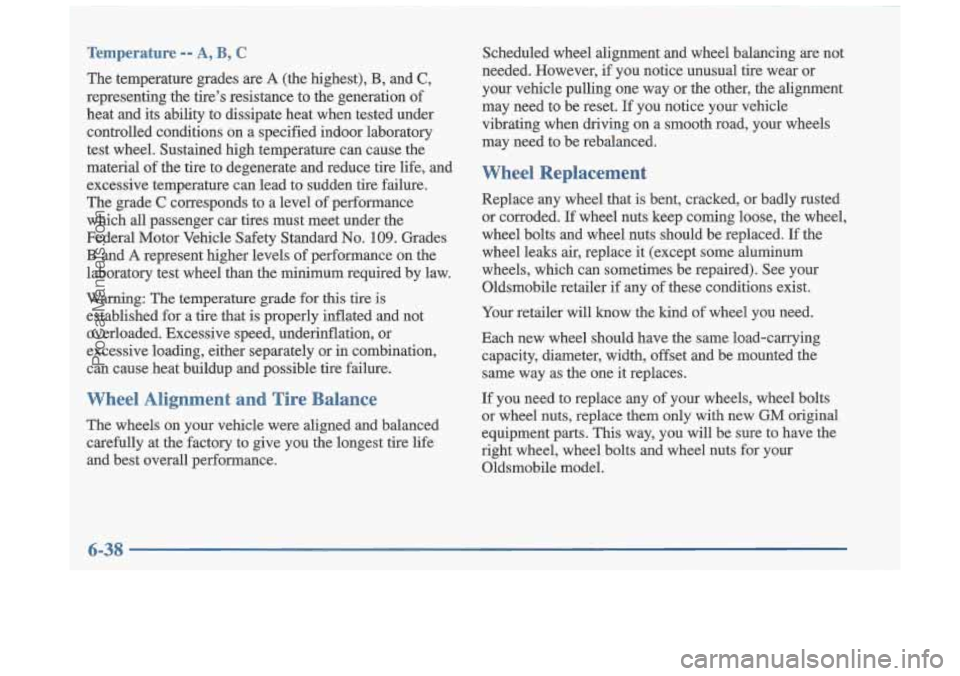
Temperature -- A, B, C
The temperature grades are A (the highest), B, and C,
representing the tire’s resistance to the generation of
heat and its ability to dissipate heat when tested under
controlled conditions on a specified indoor laboratory
test wheel. Sustained high temperature can cause the
material of the tire to degenerate and reduce tire life, and
excessive temperature can lead to sudden tire failure.
The grade
C corresponds to a level of performance
which all passenger car tires must meet under the
Federal Motor Vehicle Safety Standard
No. 109. Grades
B and A represent higher levels of performance on the
laboratory test wheel than the minimum required by law.
Warning: The temperature grade
for this tire is
established for a tire that is properly inflated and not
overloaded. Excessive speed, underinflation, or
excessive loading, either separately
or in combination,
can cause heat buildup and possible tire failure.
Wheel Alignment and Tire Balance
The wheels on your vehicle were aligned and balanced
carefully at the factory to give you the longest tire life
and best overall performance. Scheduled wheel alignment and wheel balancing are not
needed. However, if you notice unusual tire wear
or
your vehicle pulling one way or the other, the ali-gnment
may need to be reset.
If you notice your vehicle
vibrating when driving on a smooth road, your wheels
may need to be rebalanced.
Wheel Replacement
Replace any wheel that is bent, cracked, or badly rusted
or corroded. If wheel nuts keep coming loose, the wheel,
wheel bolts and wheel nuts should be replaced.
If the
wheel leaks
air, replace it (except some aluminum
wheels, which can sometimes be repaired). See your
Oldsmobile retailer if any
of these conditions exist.
Your retailer will know the kind of wheel you need.
Each new wheel should have the same load-carrying capacity, diameter, width, offset and be mounted the same way as the one it replaces.
If you need to replace any of your wheels, wheel bolts
or wheel nuts, replace them only with new GM original
equipment parts. This way, you will be sure to have the
right wheel, wheel bolts and wheel nuts for your Oldsmobile model.
ProCarManuals.com